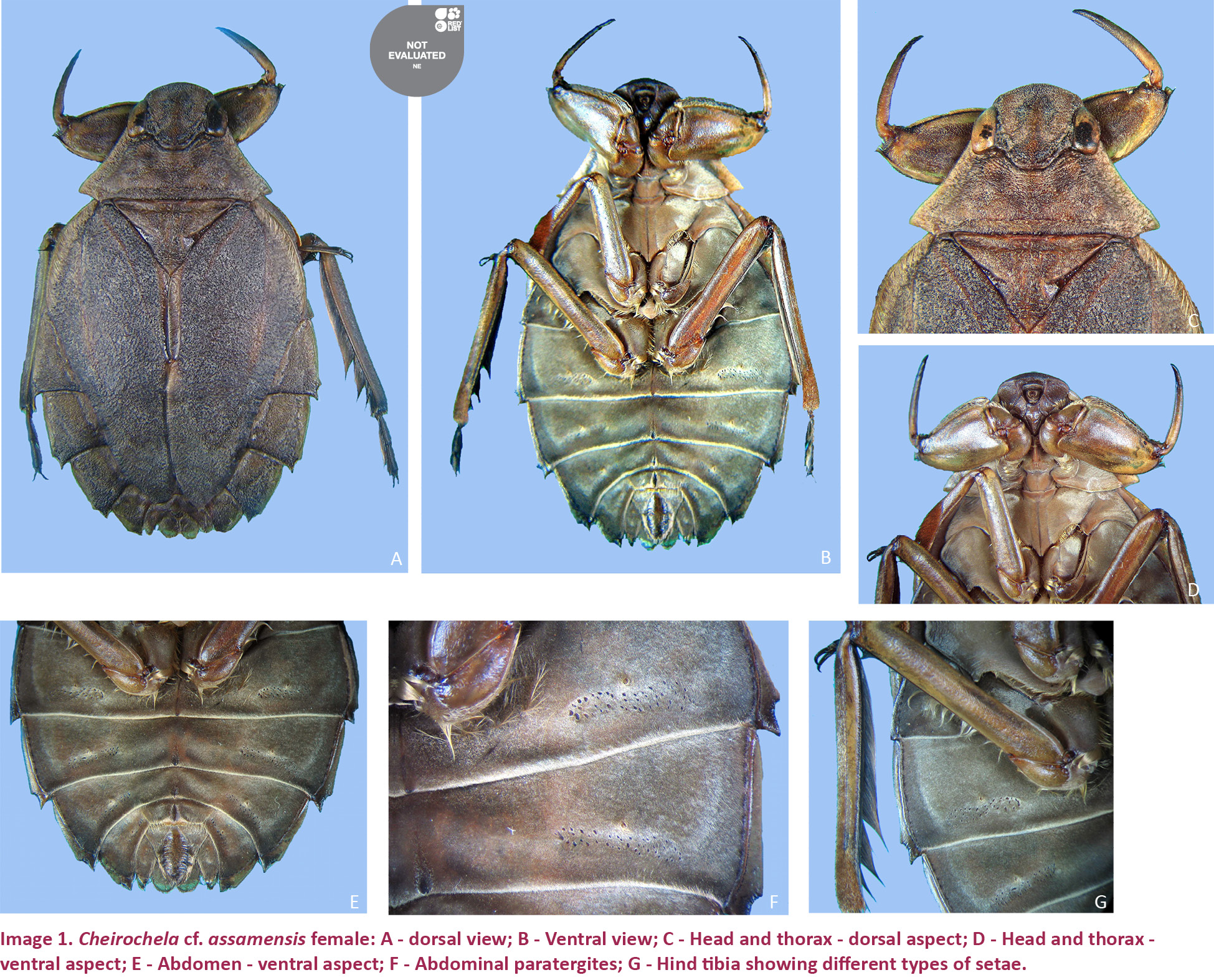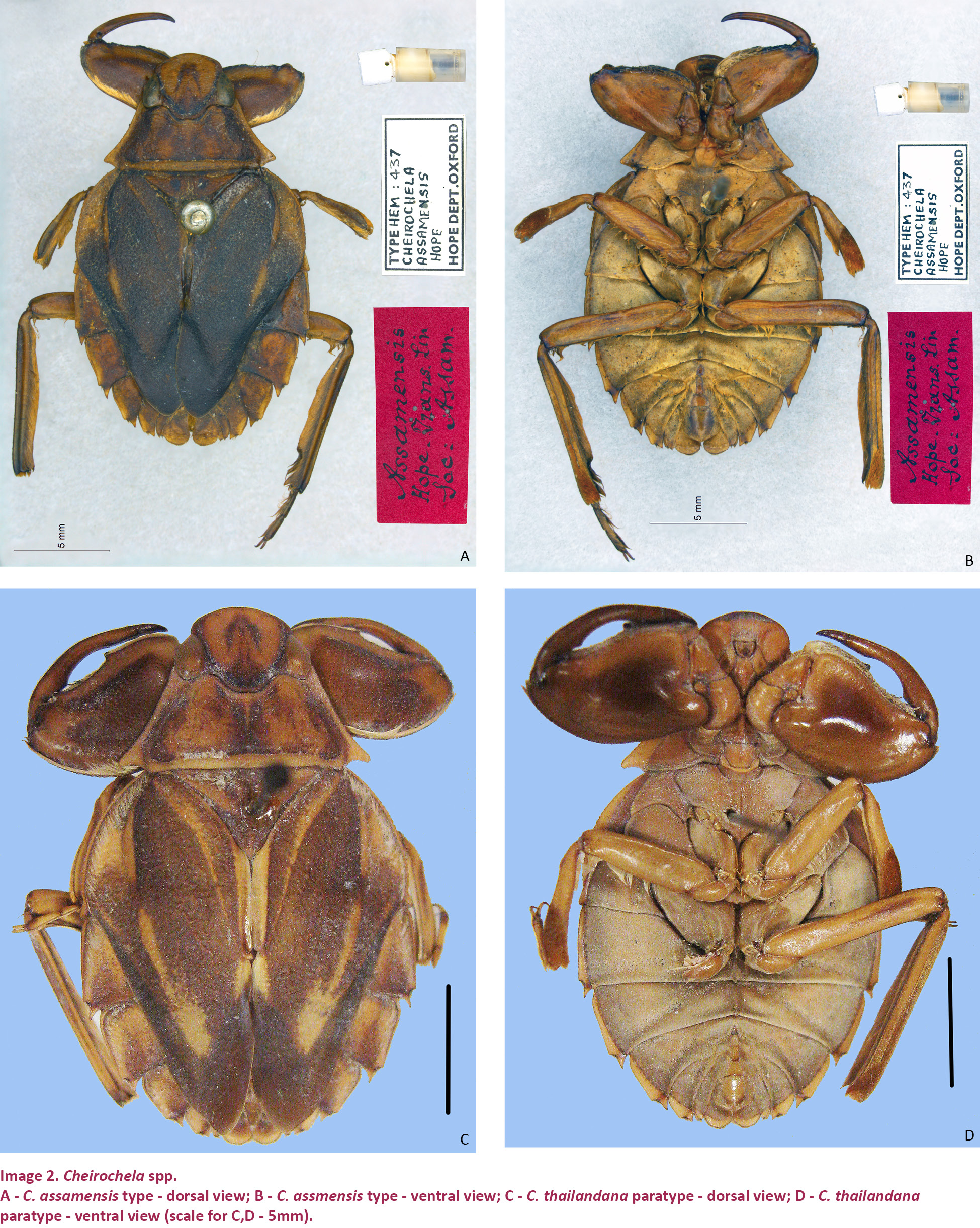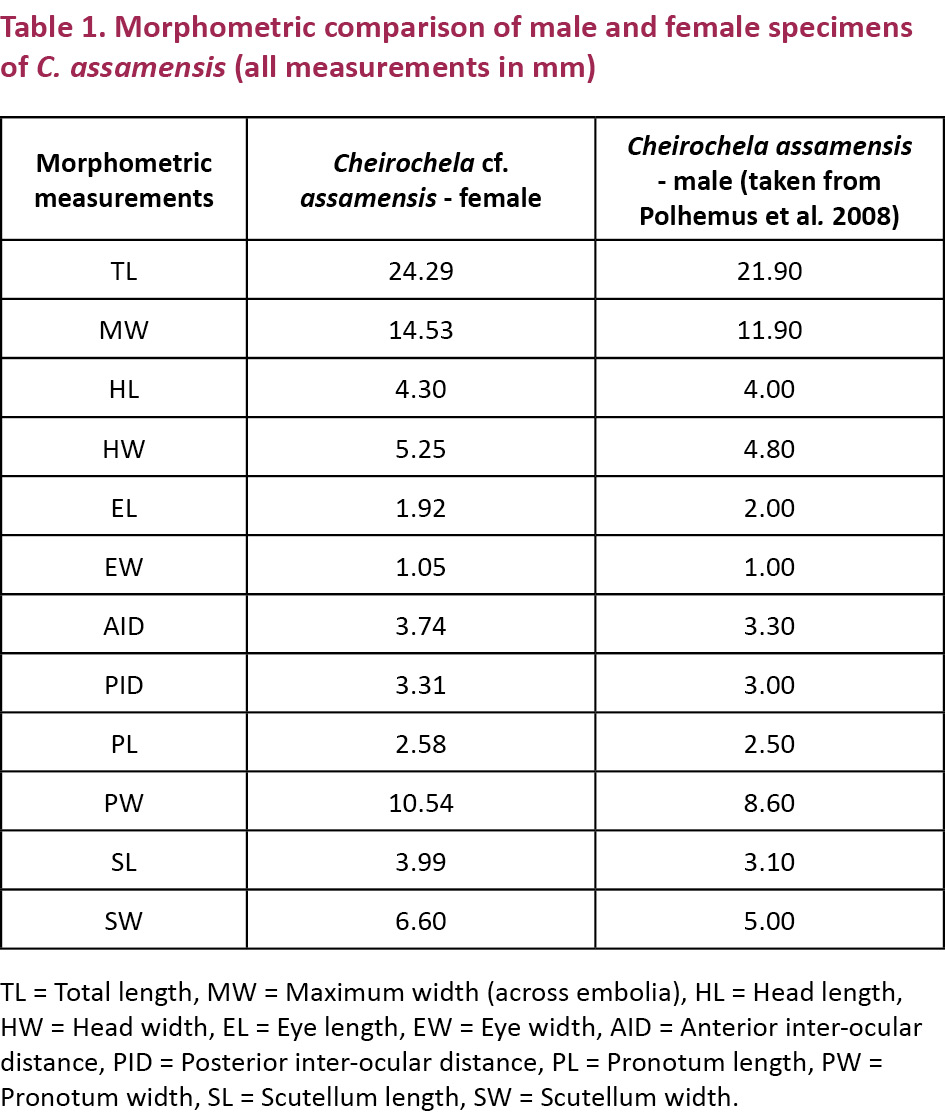First report of the female of Cheirochela assamensis Hope, 1841 (Hemiptera: Heteroptera: Naucoridae) from northeastern India
Shruti V. Paripatyadar 1, Sophio Riphung 2 & H.V. Ghate 3
1 Department of Biodiversity, MES’s Abasaheb Garware College, Pune, Maharashtra 411004, India
2 Plant Quarantine Station, Ashirwad, Airport Road, Lankeshwar, Jalukbari, Guwahati, Assam 781014, India
3 Department of Zoology, Modern College of Arts, Science and Commerce, Shivajinagar, Pune, Maharashtra 411005, India
1 shruti.paripatyadar@gmail.com, 2 sophioriphung@gmail.com, 3 hemantghate@gmail.com (corresponding author)
Abstract: This publication reports for the first time the female of a Naucorid Bug Cheirochela assamensis Hope, 1841 from the state of Meghalaya, India. This species has been known so far by only two male specimens. We provide a detailed description of the female and light microscopic images of the habitus and important characters. Habitus photos of type (male) of C. assamensis and a related species, Cheirochela thailandana Polhemus et al. are also provided for comparison.
Keywords: Cheirochelini, creeping water bug, Heteroptera, Meghalaya, Naucoridae.
doi: http://dx.doi.org/10.11609/JoTT.o4162.6815-20 | ZooBank: urn:lsid:zoobank.org:pub:2209027F-C160-4BE8-A001-97D7FA21339A
Editor: Robert W. Sites, University of Missouri, Columbia, USA. Date of publication: 26 January 2015 (online & print)
Manuscript details: Ms # o4162 | Received 29 September 2014 | Final received 05 January 2015 | Finally accepted 08 January 2015
Citation: Shruti V. Paripatyadar, Sophio Riphung & H.V. Ghate (2015). First report of the female of Cheirochela assamensis Hope, 1841 (Hemiptera: Heteroptera: Naucoridae) from northeastern India. Journal of Threatened Taxa 7(1): 6815–6820; http://dx.doi.org/10.11609/JoTT.o4162.6815-20
Copyright: © Paripatyadar et al. 2015. Creative Commons Attribution 4.0 International License. JoTT allows unrestricted use of this article in any medium, reproduction and distribution by providing adequate credit to the authors and the source of publication.
Funding: Partly self funded; SVP - UGC-JRF (Sr. No. 2121030936).
Competing Interest: The authors declare no competing interests.
Acknowledgements: We are thankful to the authorities of Modern College, Pune 5, and Biodiversity Department, Garware College, Pune 4, for facilities and encouragement. SVP thanks UGC New Delhi for the JRF. SVP also thanks Dr. Anand Padhye for his support and encouragement. SVP is grateful to Dr. Thomas Henry (Curator in charge - Heteroptera collection, United States National Museum of Natural History, Washington DC, USA) for giving the permission to visit and study the Heteroptera collection at the NMNH. SVP is also grateful to Dr. Gerry Cassis (President, International Heteropterists’ Society), International Heteropterists’ Society (IHS) Executive and Mrs. Annemarie Møller Andersen, for providing financial assistance (The Nils & Annemarie Møller Andersen Award) to attend the ‘Fifth Quadrennial IHS meeting’ in Washington, DC, from 21-25 July 2014 and visit Smithsonian Institution’s National Museum of Natural History in Washington DC, USA. Finally, we gratefully acknowledge Dr. R.W. Sites (Enns Entomology Museum, University of Missouri, Columbia, USA) and Dr. D.A. Polhemus (Bishop Museum, Honolulu, Hawaii, USA) for all the help with the identification. We specially thank Dr. Sites and Prof. C. Viraktamath (GKVK, Bangalore) for their valuable comments on the first draft of the manuscript. We also acknowledge Mr. Alan Hadley for the freeware Combine ZM and Biodiversity Heritage Library for making the original description of the species available online. We are extremely grateful to the authorities of the Oxford University Museum of Natural History, Hope Entomological Collections, Ms. Amoret Spooner for making the images of the type of Cheirochela assamensis Hope available and to Ms. Katherine Child for excellent photographs. These photos are copyright of the Oxford University Museum of Natural History and should not be reused by others without prior permissions. We are also grateful to Dr. Thomas Henry for permitting the use of the images of the paratype of C. thailandana Polhemus et al. preserved in the Smithsonian Institution’s National Museum of Natural History (Washington DC, USA). The copyright of these images rests with the National Museum of Natural History.

The aquatic Heteroptera of India have not received much attention in recent years, even though work on these bugs is being actively pursued in neighbouring countries and elsewhere in Southeast Asia. The recent checklist of aquatic bugs of India (Thirumalai 2007) includes this species but indicates no fresh collection. For many species distribution data are wanted and most species actually need detailed re-descriptions, digital documentation of their habitus and important morphological features, as well as their habitats.
The family Naucoridae, or the creeping water bugs, are distributed worldwide with remarkable species richness in the Oriental region (Polhemus & Polhemus 2013). Their typical habitats include fast flowing streams and slower parts of streams and ponds with preference to pebbly substratum (Polhemus 1979). Naucoridae are represented in India by the subfamilies Laccocorinae, Naucorinae and Cheirochelinae (Thirumalai 2007). Laccocorinae and Naucorinae are distributed widely throughout India. Cheirochelinae are restricted to the northeastern part of the country and Cheirochela assamensis Hope was originally described from Assam, and subsequently recorded from Meghalaya (Hope 1841; Distant 1906; Polhemus et al. 2008).
Cheirochelinae contain 10 genera (La Rivers 1971) and occur only in the Old World (Polhemus 1979).These insects are distributed in Indochina, Borneo, Philippines and New Guinea (Polhemus et al. 2008). The tribe Cheirochelini is believed to form a monophyletic clade within the Naucoridae and contains the genera Cheirochela Hope, 1841, Gestroiella Montandon, 1897 and Coptocatus Montandon, 1909, of which Cheirochela and Gestroiella are found in northeastern India. Currently, Cheirochela includes five species. To date, only two species from Cheirochelini, namely Cheirochela assamensis Hope (Hope 1841) and Gestroiella insignis Distant (Distant 1910) are known from India. Coptocatus is known only from Borneo (Polhemus et al. 2008).
The tribe Cheirochelini, especially the Indochinese genera Cheirochela and Gestroiella, remained neglected for most part of the 20th century, partly because of scanty collections and for other reasons which have been explained in detail by Polhemus et al. (2008) in their recent revision.
Cheirochela assamensis is the only species of the genus known in India. The male was described by Hope (1841) from an uncertain locality in Assam and the same specimen was subsequently used by Distant (1906) to describe the characteristics of the species. Polhemus et al. (2008) later used the holotype as well as a specimen collected from West Garo Hills, Nokrek, Meghalaya, for the revision of the genera Cheirochela and Gestroiella. These are the only two specimens of C. assamensis known so far and both are males. The generic key given in Polhemus et al. (2008) is based on the male characters only and there is no information available on the female.
Here we report a female specimen from Meghalaya (exact locality unknown) that we provisionally identify as C. assamensis, as most of the characters given by Hope match well. Collection of the female along with the male is necessary for absolute certainty of identification. This is the first report of the female of this species. A detailed description along with digital images are given below.
Materials and Methods
Material studied: Cheirochela cf. assamensis - Meghalaya, vii.2011, coll: Sophio Riphung (1 female). Preserved in Modern College of Arts, Science & Commerce, Pune, India, Reg. No. Heteroptera, Cheirochelinae 1.
Cheirochela thailandana Polhemus et al., 2008 - Doi Nangka, northern Thailand, 19.iv.1931, coll: H.M. Smith, National Insect Collection, National Museum of Natural History, Washington DC, USA (1 male). Photographs taken by Shruti Paripatyadar.
The specimen was studied and photographed under stereo-zoom trinocular microscope (Leica MZ6) with a camera attachment (Canon PowerShot S50). Several images were taken at different focal planes and were stacked using Combine ZM image-stacking freeware. The digital photographs were processed using Adobe Photoshop CS5 version 12.00. The specimen was measured using a digital caliper (AEROSPACE, 0-150 mm).
Description
Brachypterous female. Length: 24.3mm; maximum width (across embolia) 14.5mm (Images 1A, B). Large, oblong-oval bug, with an extremely flattened body. Colour mostly blackish-brown. Ventrally densely covered with very fine, adpressed, brownish and golden pubescence, leaving only small areas, including legs, without dense pubescence.
Head: Elongate, uniformly blackish-brown, broader anteriorly than posteriorly. Median region convex with shallow depression on either side, lateral areas slightly convex. Dorsal surface covered with fine setae that appear as white spots. Remaining area granular; in some parts, granules black and shiny. Eyes elongate, broader posteriorly, gradually narrowing anteriorly as seen from above, inner margins parallel. Vertex produced behind as lobe which fits in anterior emargination of pronotum (Image 1C). Different parts of head not distinctly seen dorsally as no sutures are visible.
Head ventrally with large, elongate cavity through which short rostrum protrudes, leaving empty space all around. Fringe of dense setae on the upper margin (clypeus) of this cavity. Lateral to cavity are mandibular plate and maxillary plate on either side, labrum extremely short and above rostrum. Gular area with triangular raised keel having few teeth just posterior to cavity. Labium brown. Antennae set in cavity beneath eyes, all segments thickened, subequal in length, shiny white due to pubescence, last segment with long, golden pubescence. Cavity in which antenna is situated almost touches eye.
Thorax: Pronotum much broader than long as measured at midline, distinctly narrowed anteriorly. Lateral margins slightly concave, very finely crenulated. Anterior border sinuate, with deep groove on either side to accommodate eyes and median emargination to accommodate posterior lobe of vertex. Posterior border more or less straight for most of its length, slightly directed forward at the corners. Anterior angles acute and end slightly before middle of eyes, posterior angles also acute. Dorsal surface of pronotum with deep transverse groove near base, rugulose behind posterior projection of vertex and with blackish granules elsewhere. Area anterior to basal groove darker than area behind. Overall, disc slightly convex, area behind vertex shallow, remaining part with laminate margin which is paler in colour than rest of disc (Image 1C). Prosternal keel laterally compressed between coxae, posteriorly broadened. Metasternal process (or metaxyphus) small, robust, roughly quadrangular in shape, bordered with long, golden setae (Image 1B). Small pit between union of pro- and mesosternum (or sternellum); median sulcus on mesosternum (Image 1D).
Scutellum triangular, broader than long, with deep, transverse groove at base and two lateral, deep notches near the middle on either side. Area within notches deep brown, shining, with large punctures. Overall, disc of scutellum granular, with shallow median groove along 3/4th of its length, area near apex with distinct, transverse folds (Image 1C).
Hemelytra broad basally, narrowing posteriorly, not reaching tip of abdomen and not covering connexivum. Entire surface of clavus rugulose, except median overlapping region (claval commissure) which is shining brown and smooth, membrane lacking. Hook-like structure on left corium with corresponding notch on right corium. The entire surface of corium rugulose, punctate. Claval suture and embolar suture pale ochraceous. Lateral margin of embolium from pronotum to first visible abdominal segment covered with golden setae (Image 1A). These long, golden setae are on inner edge of the margin and appear adpressed mesad (which might be a preservation artifact) and not outwardly erect as shown for C. tonkina in Polhemus et al. (2008).

Legs: All legs flattened, shining, pale brownish.
Forelegs: Prominent due to broad femora. Coxa prominent, rounded and smooth, almost jutting onto prosternal process, without punctures but with a few thin rugae where it joins trochanter. Trochanter small; outer edge with thick golden setae; with prominent, erect spine on inner edge close to femur. Femur flat, grossly dilated, ventral surface smooth, anterior edge with dense covering of dark grey pubescence, posterior edge dark brown with dark brown to black, small spines. Tibia long, gradually narrowing. Tarsus 1/4th length of tibia, one-segmented, together with tibia forming a hook-like structure. Tibio-tarsus internally grooved, apex dark brown, entire surface with fine punctures, with inner fringe of fine setae (Image 1D).
Midlegs: Coxa concave on outer side; cavity lined with long, dense pubescence. Distal portion of coxa with single, moderate sized tubercle. Trochanter wedge shaped, partly covered with golden pubescence at base, distal area smooth and shiny. Femur flattened, smooth with transverse striations at distal outer margin, parallel sided, slightly narrowing distally. Tibia shorter than femur, with proximal half shining, pale ochraceous, distal half covered with dense mat of curved, brown hooks on inner surface, with long, golden and dark brown setae at apex. Tarsus brown, two segmented. Claws equal, long, stout (Image 1B).
Hindlegs: Longest of legs. Coxa raised above the level of metasternum. Coxal base, apex, and entire area between coxae, covered with long, golden setae,basal area with some naked black spots appearing dark brown due to lack of pubescence, similar to those on abdominal paratergites. Trochanter partly covered with long, golden setae, distal half shiny and smooth, without setae. Femur almost parallel sided, flat with dense fringe of hairs on inner edge (Image 1B). Tibia longer than femur, ventral inner margin with short, dark brown setae; ventral outer margin with long golden setae (Image 1G). Tarsus dark brown, two-segmented, covered with dark brown setae. Claws equal, long, stout, similar to midlegs (Image 1B).
Abdomen: Postero lateral corners of all visible abdominal segments produced into well defined spines. Because of concavity anterior to spines, lateral angles appear bidentate. Entire ventral surface covered with fine golden pubescence, except the area adjacent to spiracles on paratergites where small, roughly circular, clear patches of cuticle are visible (Image 1F) (=hydrostatic sense organs sensu Polhemus et al. 2008). Abdominal sternites III–VI bearing well defined median tubercle. Median tubercles of IV and V with sharp tips which do not project over bases of subsequent sternites.
Diagnosis
Tribe Cheirochelini La Rivers 1971 can be easily distinguished from the other naucorids by their large size and extremely flattened body. The rostrum is situated in a deep cavity on ventral side of head. The labrum is extremely short, situated at the base of rostrum. The foretarus and claw are fused, forming a single composite leg segment. Each abdominal sternite and paratergite is fused, forming a continuous segment.
Genus Cheirochela Hope, 1841 differs from the other genera of the tribe Cheirochelini in the presence of an erect hair pile ventrally on thorax and abdomen and a band of dense setae on the ventral margin of clypeus. C. assamensis is easily recognised by the moderate body size for the genus and the presence of a distinct, stout median tubercle, on each of the abdominal sternites IV and V, which does not project over the subsequent sternite (Image 1E). It can be distinguished from the related species C. thailandana Polhemus et al. by the following characters: shape of the median tubercles on sternites IV and V, which are angulate and project over the bases of the subsequent sternites in C. thailandana, and the shape of the metaxyphus, which is much broader in C. thailandana (verified by studying a male specimen in the collections of the United States National Museum of Natural History, Smithsonian Institution, Washington DC, USA, Image 2 C,D).

Discussion
The history of taxonomic work thus far on the tribe Cheirochelini has been treated elaborately by Polhemus et al. (2008) in their revision of the genera Cheirochela and Gestroiella. As explained in that article, the collection of the study material has been hindered for a long time due to the restricted distribution of these genera in the remote parts of Indochina and the political unrest in that area (Polhemus et al. 2008).
The genus Cheirochela was described in 1841 by F.W. Hope, who studied a single specimen collected in Assam by William Griffith. Hope described the first species C. assamensis, naming it after the collection locality (Hope 1841). The type is deposited in the Hope Entomological Museum, Oxford, UK. Polhemus et al. later used this specimen along with another specimen present in the Natural History Museum, Vienna, to describe the characters of this species in the revision (Polhemus et al. 2008).
The original description of general colouration and characters given by Hope, as well as the specific characters given in Polhemus et al. (2008), match well with that of our female specimen. The female appears slightly larger as compared to the males of this species, based on the comparison of measurements of the female specimen and the male specimens (See Table 1). C. assamensis remains the only species of the genus known to be present in India. These insects appear to be comparatively rare and thorough surveys in remote parts of northeastern India are necessary to collect more specimens and to associate males and females collected from the same locality, in order to validate the identity of the female specimen studied by us. However, we recently obtained photographs of the extremely well preserved type of Cheirochela assamensis Hope, from ‘Hope Collections’ at Oxford Natural History Museum (Image 2 A,B). Comparing our specimen with these photos clearly indicates that the specimen reported in this short note is indeed a female of C. assamensis.

References
Distant, W.L. (1906). The Fauna of British India, Including Ceylon and Burma. Rhynchota, Vol. 3. Heteroptera - Homoptera. Taylor & Francis, London, xiv+503pp.
Distant, W.L. (1910). The Fauna of British India, Including Ceylon and Burma. Rhynchota, Vol. 5. Heteroptera: Appendix. Taylor & Francis, London, xii+362pp.
Hope, F.W. (1841). XXVI. Descriptions of some new insects, collected in Assam by William Griffith, Esq., Assistant-Surgeon in the Madras Medical Service, and attached to the late Scientific Mission to Assam. Transactions of the Linnean Society of London 18: 435–447; http://dx.doi.org/10.1111/j.1095-8339.1838.tb00192.x
La Rivers, I. (1971). Studies of Naucoridae (Hemiptera). Biological Society of Nevada Memoir, 2, iii+120pp.
Polhemus, D.A. & J.T. Polhemus (2013). Guide to the aquatic Heteroptera of Singapore and peninsular Malaysia. Xi. Infraorder Nepomorpha - Families Naucoridae and Aphelocheiridae. The Raffles Bulletin of Zoology 61: 665–686.
Polhemus, D.A., J.T. Polhemus & R.W. Sites (2008). A revision of the Indochinese genera Cheirochela and Gestroiella (Heteroptera: Naucoridae), and a review of the tribe Cheirochelini. The Raffles Bulletin of Zoology 56: 255–279.
Polhemus, J.T. (1979). Family Naucoridae/Creeping water bugs, saucer bugs, pp. 131–138. In: Menke, A.S. (ed.). The Semiaquatic and Aquatic Hemiptera of California (Heteroptera: Hemiptera). Bulletin of the California Insect Survey Vol. 21. University Of California Press, xi+166 pp.
Thirumalai, G. (2007). A synoptic list of Nepomorpha (Hemiptera: Heteroptera) from India. Records of the Zoological Survey of India Occasional Papers 273: 1–84.